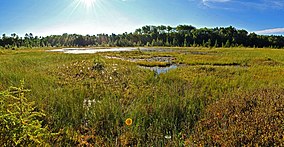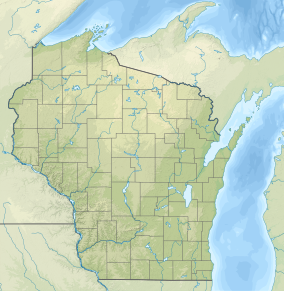| Black Tern Bog State Natural Area | |
|---|---|
 Black Tern Bog | |
| Location | Vilas, Wisconsin, United States |
| Coordinates | 45°58′1.25″N 89°41′53.11″W / 45.9670139°N 89.6980861°W / 45.9670139; -89.6980861 |
| Area | 26 acres (11 ha) |
| Established | 1967 |
Black Tern Bog State Natural Area is a Wisconsin Department of Natural Resources-designated State Natural Area featuring 20 acres (8 ha) of quaking sphagnum bog surrounding two small seepage lakes situated in a pitted outwash plain. The bog is rich in plant species, such as sundews, pitcher plant, bogbean, and bog rosemary, as well as three species of bog orchids: swamp pink, grass pink, and rose pogonia. The state-endangered bog rush (Juncus stygius) also grows here. Birds known to nest here include black tern, American bittern, killdeer, and mallards.[1][2]
Location and access[edit]
Black Tern Bog is located in southwest Vilas County, approximately 3.5 miles (5.6 km) northwest of Arbor Vitae. Access is via an unnamed dirt road off US Highway 51, north of the bog. The road wraps around the northern and eastern portions of the bog. It is also possible to park on the shoulder of US Highway 51, which passes along the western edge of the bog.[3]
-
The south end of the bog
-
The carnivorous pitcher plant (Sarracenia purpurea) growing in Black Tern Bog
-
Looking east, across the central portion of the bog
References[edit]
- ^ "Black Tern Bog State Natural Area". Wisconsin Department of Natural Resources. Retrieved 2013-12-02.
- ^ Germain, Clifford E.; Tans, William E.; Read, Robert H. "Wisconsin scientific areas 1977: preserving native diversity" (PDF).
- ^ Black Tern Bog State Natural Area (PDF) (Map). Wisconsin Department of Natural Resources. Retrieved 2013-12-01.





Well, that’s interesting to know that Psilotum nudum are known as whisk ferns. Psilotum nudum is the commoner species of the two. While the P. flaccidum is a rare species and is found in the tropical islands. Both the species are usually epiphytic in habit and grow upon tree ferns. These species may also be terrestrial and grow in humus or in the crevices of the rocks.
View the detailed Guide of Psilotum nudum: Detailed Study Of Psilotum Nudum (Whisk Fern), Classification, Anatomy, Reproduction